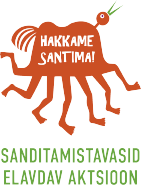Mumming is a tradition-based playful interaction between two parties, the visiting mummers and the receiving family. St. Martin’s Day and St. Catherine’s Day mummers are groups of people disguised as various animals, family members and other characters, who go door-to-door in cities and villages mainly on the eve of St. Martin’s Day and St. Catherine’s Day (9. and 24. November).
The disguises are made up of clothing (an inside-out fur or furry overclothes, gloves, scarves, skirts, beads, etc.), changing one’s voice, as well as face masks made from available materials. The mumming ritual begins with singing outside the family’s door. Performing the rituals to the accompaniment of songs is a pervasive characteristic of mumming: entrance into the house is requested by singing, the reason for their arrival, thanks and farewell are given by singing. The interaction between the mummers and the family involves the mummers asking riddles, playing instruments, dancing, singing, joking and entertaining the family. Mummers wish the family good luck, success and health for the coming year by throwing grains, peas or rice on the floor.
The family thanks the mummers with gifts: food, sweets, and more recently also money. During an evening, the mummer groups usually visit several families. Their scenes are based on traditions that are varied by themes and personalities in society at the given time. The mumming tradition has been associated with the veneration of ancestors and the autumn-winter time of the souls. Therefore, the mummers were seen as embodiments of ancestral souls. This belief, as well as the past fertility-magical function of the custom, has receded nowadays. Due to the historical background in fertility magic, the mummers have gender-specific roles: St. Martin’s Day mummers (regardless of their actual gender ) are masked as men. St. Catherine’s Day mummers are mostly masked as women.
